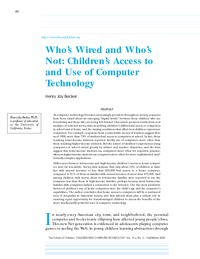Who’s Wired and Who’s NotChildren’s Access to and Use of Computer Technology
Zu finden in: Children and Computer Technology, 2000
 |
 |
 Zusammenfassungen
Zusammenfassungen
 An analysis of the extent and significance of a "digital divide" between those children who are benefitting from access to computer technology in school and at home, and those who are being left behind.
An analysis of the extent and significance of a "digital divide" between those children who are benefitting from access to computer technology in school and at home, and those who are being left behind.As computer technology becomes increasingly prevalent throughout society, concerns have been raised about an emerging "digital divide" between those children who are benefitting and those who are being left behind. This article presents results from new analyses of national survey data describing children’s differential access to computers in school and at home, and the varying conditions that affect how children experience computers. For example, responses from a nationwide survey of teachers suggest that, as of 1998, more than 75% of students had access to computers at school. In fact, those
teaching lower-income students reported weekly use of computers more often than those teaching higher-income students. But the nature of children’s experiences using computers in school varied greatly by subject and teacher objectives, and the data suggest that lower-income students use computers more often for repetitive practice,
whereas higher-income students use computers more often for more sophisticated, intellectually complex applications.
Differences between low-income and high-income children’s access to home computers were far less subtle. Survey data indicate that only about 22% of children in families with annual incomes of less than $20,000 had access to a home computer, compared to 91% of those in families with annual incomes of more than $75,000. And among children with access, those in low-income families were reported to use the computer less than those in high-income families, perhaps because most low-income families with computers lacked a connection to the Internet. The two most predictive factors of children’s use of home computers were the child’s age and the computer’s capabilities. The author concludes that home access to computers will be a continued area of inequality in American society, and that schools must play a critical role in ensuring equal opportunity for less-advantaged children to access the benefits of the more intellectually powerful uses of computer technology.
Von Henry Becker im Text Who’s Wired and Who’s Not Differences between low-income and high-income children’s access to home computers were far less subtle. Survey data indicate that only about 22% of children in families with annual incomes of less than $20,000 had access to a home computer, compared to 91% of those in families with annual incomes of more than $75,000. And among children with access, those in low-income families were reported to use the computer less than those in high-income families, perhaps because most low-income families with computers lacked a connection to the Internet. The two most predictive factors of children’s use of home computers were the child’s age and the computer’s capabilities. The author concludes that home access to computers will be a continued area of inequality in American society, and that schools must play a critical role in ensuring equal opportunity for less-advantaged children to access the benefits of the more intellectually powerful uses of computer technology.
 Bemerkungen
Bemerkungen
 Leider ist die ursprünglich im Biblionetz erfasste URL eines Volltextes seit mehr als sechs Monaten nicht mehr gültig (Fehlermeldung 404) und wurde deshalb gelöscht. Es ist mir nicht bekannt, ob das Dokument unter einer anderen Adresse noch frei auf dem Internet verfügbar ist.
Leider ist die ursprünglich im Biblionetz erfasste URL eines Volltextes seit mehr als sechs Monaten nicht mehr gültig (Fehlermeldung 404) und wurde deshalb gelöscht. Es ist mir nicht bekannt, ob das Dokument unter einer anderen Adresse noch frei auf dem Internet verfügbar ist. Dieser Zeitschriftenartikel erwähnt ...
Dieser Zeitschriftenartikel erwähnt ...
 Begriffe KB IB clear |  Computer Computer computer
, digital dividedigital divide
, computer
, digital dividedigital divide
,  Familie Familie family
, family
,  Internet Internet internet
, internet
,  Kinder Kinder children children
|
 Dieser Zeitschriftenartikel erwähnt vermutlich nicht ...
Dieser Zeitschriftenartikel erwähnt vermutlich nicht ... 
 Tagcloud
Tagcloud
 Zitationsgraph
Zitationsgraph
 Zitationsgraph (Beta-Test mit vis.js)
Zitationsgraph (Beta-Test mit vis.js)
 5 Erwähnungen
5 Erwähnungen 
- Handheld Use in K-12 - A Descriptive Account (Michael Curtis, Kathleen Luchini, William Bobrowsky, Chris Quintana, Elliot Soloway) (2002)


- Pocket PiCoMap - a case study in designing and assessing a handheld concept mapping tool for learners (Kathleen Luchini, Chris Quintana, Elliot Soloway) (2003)


- New Technology and Digital Worlds - Analyzing Evidence of Equity in Access, Use, and Outcomes (2010)


- Technology and Social Inclusion - Rethinking the Digital Divide (Mark Warschauer) (2013)



- Emerging Research, Practice, and Policy on Computational Thinking (Peter J. Rich, Charles B. Hodges) (2017)


- 5. Proto-computational Thinking - The Uncomfortable Underpinnings (Deborah Tatar, Steve Harrison, Michael Stewart, Chris Frisina, Peter Musaeus)


- 5. Proto-computational Thinking - The Uncomfortable Underpinnings (Deborah Tatar, Steve Harrison, Michael Stewart, Chris Frisina, Peter Musaeus)
 Volltext dieses Dokuments
Volltext dieses Dokuments
 Anderswo suchen
Anderswo suchen 
 Beat und dieser Zeitschriftenartikel
Beat und dieser Zeitschriftenartikel
Beat war Co-Leiter des ICT-Kompetenzzentrums TOP während er Dieser Zeitschriftenartikel ins Biblionetz aufgenommen hat. Die bisher letzte Bearbeitung erfolgte während seiner Zeit am Institut für Medien und Schule. Beat besitzt kein physisches, aber ein digitales Exemplar. (das er aber aus Urheberrechtsgründen nicht einfach weitergeben darf). Aufgrund der wenigen Einträge im Biblionetz scheint er es nicht wirklich gelesen zu haben. Es gibt bisher auch nur wenige Objekte im Biblionetz, die dieses Werk zitieren.









 , 120 kByte)
, 120 kByte)  Biblionetz-History
Biblionetz-History